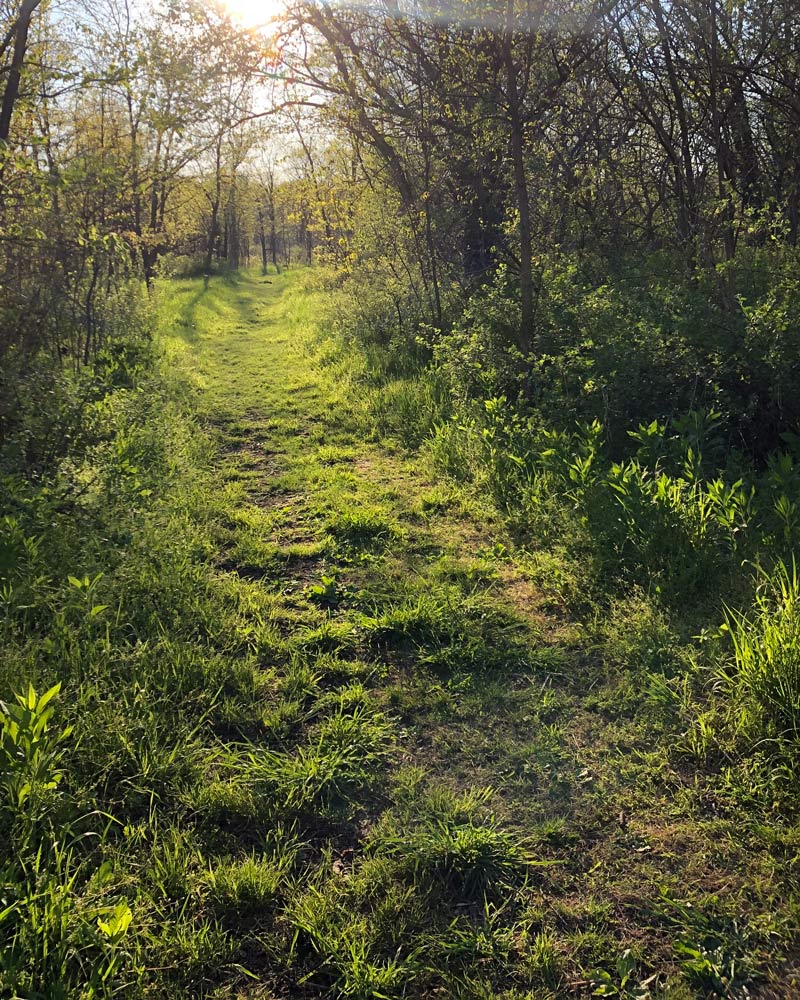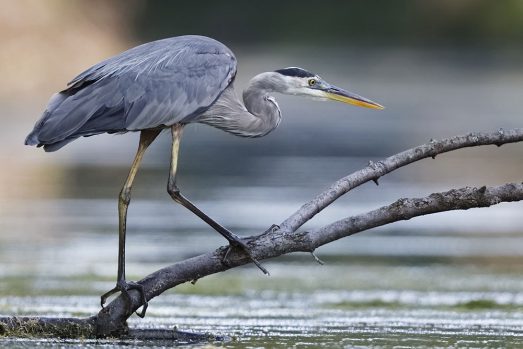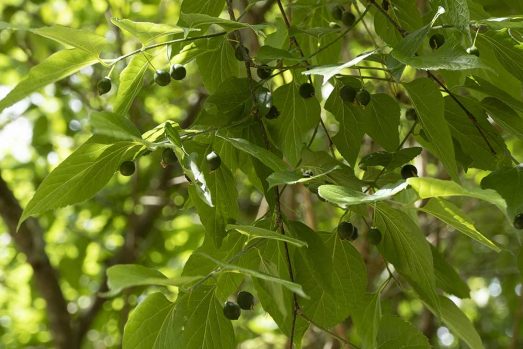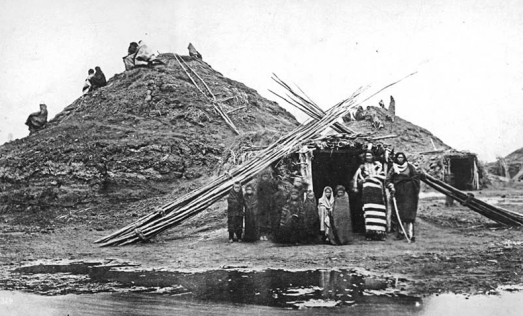Imagine strolling on what may have been trails forged by Native Americans, experiencing the golden light from a Nebraska sunrise through the treetops of massive bur oaks and cottonwoods bordering the rushing waters of Salt Creek. You hear the call of a red-tailed hawk, the splashing of beavers, and see the flash of a red fox or a fawn chasing its mother.
This is the beauty of Wilderness Park, Lincoln’s largest public park. The seven-mile, linear, 1,472-acre woodland is nestled just west of the Jamaica North Trail along Salt Creek from Van Dorn Street to Saltillo Road. The park features 31 miles of hiking, cycling, and horse trails within its naturally wooded landscape. The hiking trail was designated part of the National Recreation Trails Program in 1977.
Lincoln’s wildest park does not fit neatly into conventional definitions of parks and wilderness areas, but its uniqueness is what makes it special. For years, Wilderness Park’s dense forest, meadows, and creek beds have protected Lincoln from serious flooding. Hikers, cyclists, bird watchers, horseback riders, and other park visitors find solace and peace among the big bluestem, Dutchman’s breeches, trout lilies, and a wide variety of flora, fauna, insects, birds, and critters.
Lincolnites are fortunate to have such a unique opportunity to enjoy and appreciate a natural area so close to home.
“Wilderness Park has a very interesting history – it was the land of the Otoe-Missouria and the Pawnee,” said Adam Hintz, president of Friends of Wilderness Park. “The trails are actually on top of the same hunting trails the Pawnee used. You see a lot of remnants of the past here, all part of a lowland forest that has been intact and undisturbed for many years.”
The parks of Lincoln’s early days
From the founding of Lincoln (1856) through the mid-20th century, the Wilderness Park area was home to multiple attractions and parks. For many, memories of Epworth Lake Park, Lincoln Park, and Electric Park are scrambled. But each location plays a part in the history of this area.
Lincoln Park was a private recreational enterprise established by local businessmen in 1894. Lincoln Park was bound by Van Dorn Street on the north, Calvert Street on the south, First Street on the east, and what would be Southwest Sixth Street on the west. An article in the Nebraska State Journal on Nov. 22, 1895, stated: “(Lincoln Park) is throughout a picturesque landscape of wooded hills, winding streams and grassy meadows that has from time to time been provided with magnificent drives, football and baseball fields, tennis courts, bathing and boating pavilions, swings, etc. Then there is the zoological department … and last, but not least, a race track.”
By 1915, Lincoln Park had a new owner and billed itself as Lincoln’s newest amusement resort, Electric Park. Attractions included operetta, acrobatics, live comedy, motion pictures, concerts, boating, vaudeville, and cabarets. Admission was 10 cents per person. In 1916, 450 incandescent lights and 12 arc lights were added at the corner of First and Van Dorn streets, making it truly an “Electric Park.” The attraction was closed by 1927.
In the early 1900s, the portion of the park southeast of First and Calvert streets became known as Epworth Lake Park. This was a popular gathering spot and summer resort for the Methodist Church, featuring an open-air auditorium, campground, hotel, grocery store, and Epworth Lake, the site of the park’s “Venetian Nights,” in which families could rent ornately decorated rafts and rowboats. Epworth Lake Park attracted thousands of visitors by train, streetcars, and trolley. The park also featured animal shows, musical acts, magicians and hosted popular speakers such as Theodore Roosevelt, William Jennings Bryan, Howard Taft, Booker T. Washington, and Billy Sunday – reminiscent of those held in Chautauqua, New York.
In 1935, 14 inches of rain fell over the course of one week, causing flooding that destroyed most of the buildings in the park. Unsuccessful efforts were made to reopen the park, but American culture had changed with the advent of cars and mass communication. Families no longer needed to physically attend major speeches or concerts as they could now listen to them on the radio. Similarly, automobiles meant that families could quickly drive wherever they pleased for relatively low cost, and they no longer relied on the trains and streetcars that helped to make Epworth Lake Park thrive.
That same year, the Cornhusker Council of Boy Scouts began leasing the former Electric Park land and converted the park into its permanent camp. The council and volunteers built a swimming pool and longhouse while the Lion’s Club built a dining hall. The new facility was dubbed Camp Minis-Kuya, which some sources say can be translated from the Sioux as “salt water.” The camp closed in 1966.
In 1972, Camp Minis-Kuya, the former Epworth Lake Park, and other parcels were combined into what we know today as Wilderness Park.
Improvements needed
For many years, the City of Lincoln has acknowledged the need to make improvements to Wilderness Park to ease accessibility and support the primary purpose of the park, which is to provide protection from major floods. In 2020, more than 250 people responded to community surveys conducted by the Lincoln Parks and Recreation Department regarding the improvements and priorities of Wilderness Park. A committee representing nine user groups worked through suggestions and ideas to update the park’s master plan.
“This beautiful refuge in the heart of our city is in need of repairs,” said Mayor Leirion Gaylor Baird. “It has suffered its own damage from weather and severe storms. Bridges are in need of upgrading. We need to invest in this beautiful place that gives us such an incredible quality of life. Whether you are a cyclist, a hiker, a runner, or a family member who likes to come here seeking refuge and moments of contemplation and peace, away from the hubbub of the city, this park is here, for all of us.”
This summer, Lincoln Parks Foundation is partnering with the City and the Friends of Wilderness Park to lead a $2.1 million campaign to enhance the public’s access, usage, enjoyment, and appreciation of Wilderness Park, now and in the future.
“Few cities have an accessible wilderness expanse that provides opportunities for recreation and flood control,” said Bradley Brandt, president of Lincoln Parks Foundation, the nonprofit organization that provides private funds for the Lincoln Parks and Recreation Department. “Wilderness Park is also an added attraction for families seeking to live and work in Lincoln, providing year-round activities. Lincoln Parks Foundation is excited to lead this effort.”
The project will fund improvements at seven of the park’s trailheads, including kiosks (with maps, trail etiquette, history, and descriptions of each area), wayfinding signage, seasonal portable restrooms where possible, additional picnic tables, programmable solar lighting, parking lot grading, parking bollards and concrete pads for ADA parking. Also included are improved or replaced bridges and channel crossings, a new fitness loop, and restoration of the historic Epworth Lake Park arches.
“We want to make sure that people have a comfortable and safe experience in the park, and part of that means having understandable signage, safe bridges, and kiosks at the trailheads that will have the information you’ll need to visit the park,” Hintz said. “We want people to discover Wilderness Park and fall in love with this place so they keep coming back. It’s that natural legacy that we are responsible for now so future generations can enjoy it and keep the fabric of the community together.”
“Wilderness Park has been protecting the City of Lincoln from floods for years,” said Gaylor Baird. “Now it’s our turn to protect Wilderness Park.”
For more information about the “It’s Your Wilderness” campaign, contact Lincoln Parks Foundation at 402-441-8258 or see LincolnParks.org.
BY SUSAN LARSON RODENBURG AND MAGGIE STUCKEY-ROSS



